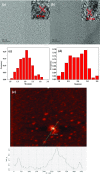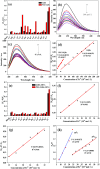Cane Molasses Graphene Quantum Dots Passivated by PEG Functionalization for Detection of Metal Ions
- PMID: 32258911
- PMCID: PMC7114702
- DOI: 10.1021/acsomega.0c00098
Cane Molasses Graphene Quantum Dots Passivated by PEG Functionalization for Detection of Metal Ions
Abstract
Poly(ethylene glycol) passivated graphene quantum dots (PEG-GQDs) were synthesized based on a green and effective strategy of the hydrothermal treatment of cane molasses. The prepared PEG-GQDs, with an average size of 2.5 nm, exhibit a brighter blue fluorescence and a higher quantum yield (QY) (up to approximately 21.32%) than the QY of GQDs without surface passivation (QY = 10.44%). The PEG-GQDs can be used to detect and quantify paramagnetic transition-metal ions including Fe3+, Cu2+, Co2+, Ni2+, Pb2+, and Mn2+. In the case of ethylenediaminetetraacetic acid (EDTA) solution as a masking agent, Fe3+ ions can be well selectively determined in a transition-metal ion mixture, following the lowest limit of detection (LOD) of 5.77 μM. The quenching mechanism of Fe3+ on PEG-GQDs belongs to dynamic quenching. Furthermore, Fe3+ in human serum can be successfully detected by the PEG-GQDs, indicating that the green prepared PEG-GQDs can be applied as a promising candidate for the selective detection of Fe3+ in clinics.
Copyright © 2020 American Chemical Society.
Conflict of interest statement
The authors declare no competing financial interest.
Figures






Similar articles
-
Highly luminescent polyethylene glycol-passivated graphene quantum dots for light emitting diodes.RSC Adv. 2020 Jul 22;10(46):27418-27423. doi: 10.1039/d0ra02257h. eCollection 2020 Jul 21. RSC Adv. 2020. PMID: 35516959 Free PMC article.
-
Synthesis of highly fluorescent nitrogen-doped graphene quantum dots for sensitive, label-free detection of Fe (III) in aqueous media.Biosens Bioelectron. 2014 Aug 15;58:219-25. doi: 10.1016/j.bios.2014.02.061. Epub 2014 Mar 6. Biosens Bioelectron. 2014. PMID: 24650437
-
A glycine-functionalized graphene quantum dots synthesized by a facile post-modification strategy for a sensitive and selective fluorescence sensor of mercury ions.Spectrochim Acta A Mol Biomol Spectrosc. 2021 Feb 15;247:119090. doi: 10.1016/j.saa.2020.119090. Epub 2020 Oct 17. Spectrochim Acta A Mol Biomol Spectrosc. 2021. PMID: 33137626
-
Nitrogen-doped graphene quantum dots prepared by electrolysis of nitrogen-doped nanomesh graphene for the fluorometric determination of ferric ions.Mikrochim Acta. 2020 May 12;187(6):322. doi: 10.1007/s00604-020-04294-8. Mikrochim Acta. 2020. PMID: 32394285
-
Development of Graphene Quantum Dots-Based Optical Sensor for Toxic Metal Ion Detection.Sensors (Basel). 2019 Sep 6;19(18):3850. doi: 10.3390/s19183850. Sensors (Basel). 2019. PMID: 31489912 Free PMC article. Review.
Cited by
-
Poly(Ethylene Glycol) Functionalized Graphene Oxide in Tissue Engineering: A Review on Recent Advances.Int J Nanomedicine. 2020 Aug 12;15:5991-6006. doi: 10.2147/IJN.S249717. eCollection 2020. Int J Nanomedicine. 2020. PMID: 33192060 Free PMC article. Review.
-
Eco-Friendly Sustainable Synthesis of Graphene Quantum Dots from Biowaste as a Highly Selective Sensor.Nanomaterials (Basel). 2022 Oct 21;12(20):3696. doi: 10.3390/nano12203696. Nanomaterials (Basel). 2022. PMID: 36296886 Free PMC article.
-
A Hydrothermal Method to Generate Carbon Quantum Dots from Waste Bones and Their Detection of Laundry Powder.Molecules. 2022 Oct 1;27(19):6479. doi: 10.3390/molecules27196479. Molecules. 2022. PMID: 36235015 Free PMC article.
-
In vitro study: green synthesis and evaluation of MgO/C-dots/DOX phosphorescent nanocomposites for photodynamic/photocatalytic therapy of tumors.Front Bioeng Biotechnol. 2023 Nov 22;11:1286955. doi: 10.3389/fbioe.2023.1286955. eCollection 2023. Front Bioeng Biotechnol. 2023. PMID: 38076426 Free PMC article.
-
Improvement of Cs detection performance and formation of CsCl and Cs nanoparticles by tuning graphene oxide quantum dot-based nanocomposite.RSC Adv. 2022 Jul 6;12(30):19667-19677. doi: 10.1039/d2ra02091b. eCollection 2022 Jun 29. RSC Adv. 2022. PMID: 35865579 Free PMC article.
References
-
- Ju B.; Wang Y.; Zhang Y. M.; Zhang T.; Lu Z. H.; Li M. J.; Zhang S. X. A. Photostable and Low-Toxic Yellow-Green Carbon Dots for Highly Selective Detection of Explosive 2,4,6-Trinitrophenol Based on the Dual Electron Transfer Mechanism. ACS Appl. Mater. Interfaces 2018, 10, 13040–13047. 10.1021/acsami.8b02330. - DOI - PubMed
-
- Pan J. Q.; Sheng Y. Z.; Zhang J. X.; Wei J. M.; Huang P.; Zhang X.; Feng B. X. Preparation of carbon quantum dots/TiO2 nanotubes composites and their visible light catalytic applications. J. Mater. Chem. A 2014, 2, 18082–18086. 10.1039/C4TA03528C. - DOI
-
- Wang L. P.; Wu X. Q.; Guo S. J.; Han M. M.; Zhou Y. J.; Sun Y.; Huang H.; Liu Y.; Kang Z. H. Mesoporous nitrogen, sulfur co-doped carbon dots/CoS hybrid as an efficient electrocatalyst for hydrogen evolution. J. Mater. Chem. A 2017, 5, 2717–2723. 10.1039/C6TA09580A. - DOI
LinkOut - more resources
Full Text Sources

